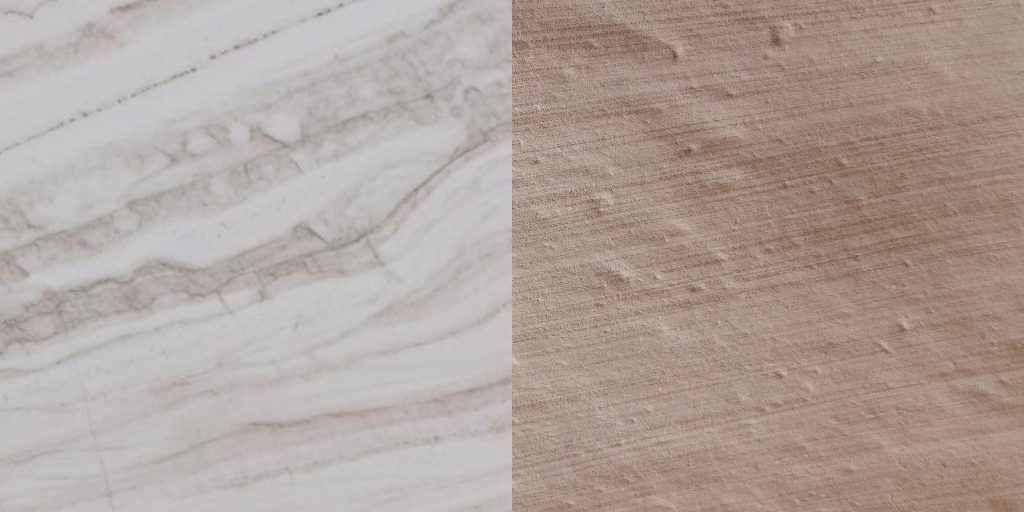Comparing Quartzite & Sandstone
Running a shop that works with slabs brings you into contact with a variety of materials. Natural stone materials and engineered materials are two of the main categories under which specific materials fall. In this post, we are going to match up two from the first category and see how they compare to one another. That’s right two natural stone materials will be look at in this article as we examine the match up: quartzite vs. sandstone. Additionally, we will see why the dust from working with these materials needs to be controlled and how controlling it can be accomplished. So let’s get into our comparison.
Sandstone Summary
The basic overview of sandstone put in layman’s terms is this: sandstone is a rock that forms sand particles get stuck together by another substance. The grain of sand can be bonded to varying degrees, but the outcome is a stone that is hard and solid. The result is a natural stone that is composed mainly of material containing silica (the main ingredient in a lot of sand). So then, we can say that sandstone is a rock that contains a large amount of silica.
Quartzite Query
So, what is quartzite? This material, like sandstone, is also a natural material. And it too, is made up of a large amount of silica. You see, quartzite is a natural stone that forms in an interesting way. Heat and pressure act on natural stone and the intense forces actually change that stone into quartzite. So what is the stone that gets changed into quartzite? In other words, what was quartzite before it became “quartzite”? The answer is an interesting one in the context of this article. Quartzite is sandstone that natural forces changed into a different rock. That means then, that quartzite too contains a large amount of silica, since it is basically transformed sandstone. You delve into this material in more detail by checking our Natural Quartzite Information article.
Comparing Sandstone and Quartzite
So how does quartzite compare with sandstone? Well, there are a number of similarities. As we mentioned above, they pretty much have the same mineral content since one becomes the other. Both types of stone are considered ‘hard’ since they reside on the high side of the Mohs scale. And whatever colors you find one of these materials in, you will most likely find the other in the same color.
You could say that quartzite is a more extreme version of what sandstone is. Sandstone ranges in hardness of about 6 to 7 and quartzite is a pretty consistent 7. Sandstone is found in a range of porosity whereas quartzite is less porous than nearly all sandstone. This is because the process that changes sandstone into quartzite is so intense that fewer pores remain after the change. So again, quartzite is more extreme in its non-porous trait. But the fact that each of these materials contains a large amount of silica leads us to another key point of this article, dust control.
Controlling Sandstone and Quartzite Dust
If you are thinking that dust control for either of the these materials is important, then you are exactly right. After all, the dust particles are going to contain SiO2 which is toxic for humans to inhale. Note this statement on the PubChem website:
Inhalation of fine crystals is toxic to humans leading to respiratory toxicity.
As a result of the toxicity of breathing silica (a substance found in both materials’ dust), it is important to control the silica dust created by working with these materials. But how can this be done?
Sandstone & Quartzite Dust Control With Water Filtration
Working with either of these materials in a wet environment means there will be a combination of water and particulates mixed together in what is called slurry. Once the particles and the water are combined, something needs to be done to properly dispose of the particulates. After all, they cannot just be sent down the drain. What can be done? Using water filtration equipment, the particles are removed from the water and then the water is recycled by being pumped back into the shop for reuse. In this way the dust generated during the fabrication process is controlled. But what about areas in a shop where there is no water in use?
Quartzite & Sandstone Dry Dust Control With Air Filtering
When there is no water being used to catch the dust like there is in a wet environment, there is dust generated. However, the particles become airborne and float in the environment. Thus, there must be a control mechanism for controlling stone dust in a dry environment. Dry dust collection equipment filters the air by capturing the particles. But how does air filtration in a stone shop work? By controlling the airflow, the dust can be drawn into a machine that allows the air through a filter that captures the dust. The dust is held in a container until it is ported from the machine to a larger holding container where it stays until it is taken to the appropriate disposal facility.
As we have seen in this article, sandstone and quartzite are very similar. In fact, it could be said that some sandstone is quartzite in the making. They both have the same minerals and in fact, in the right environment sandstone is turned into quartzite. But as we also seen, both contain silica dust which must be managed in a shop so that it doesn’t present a hazard the the professionals working in the environment.

